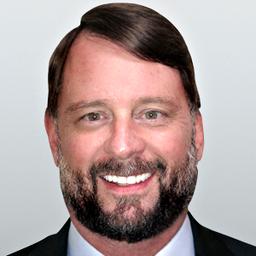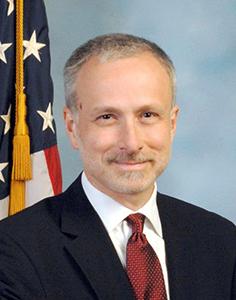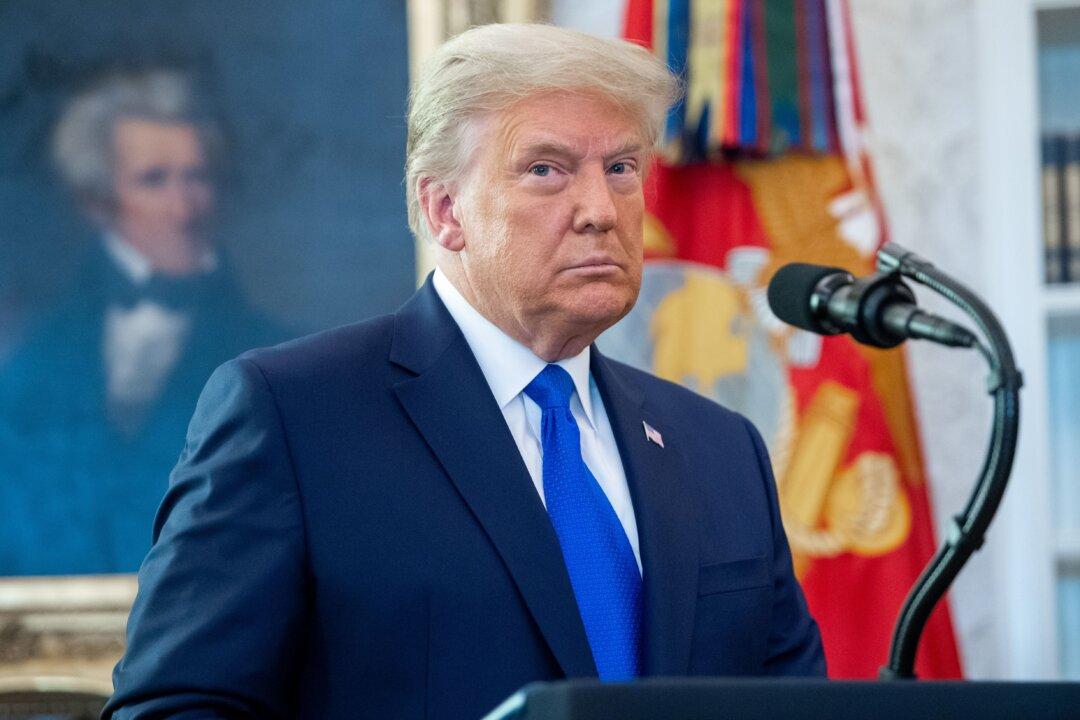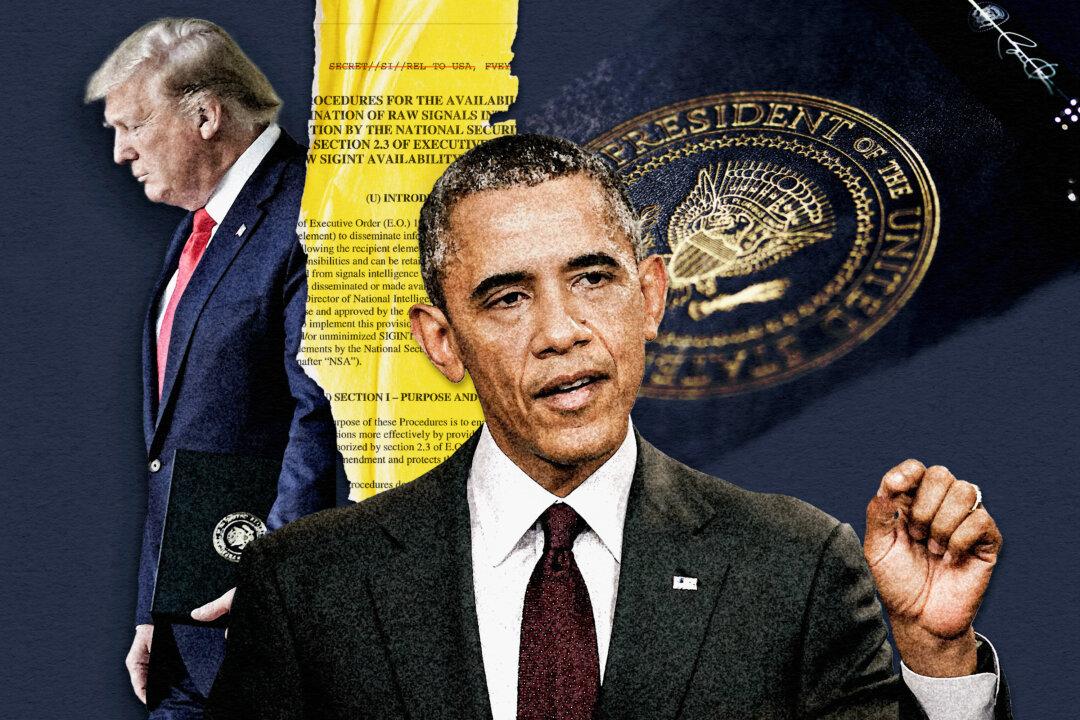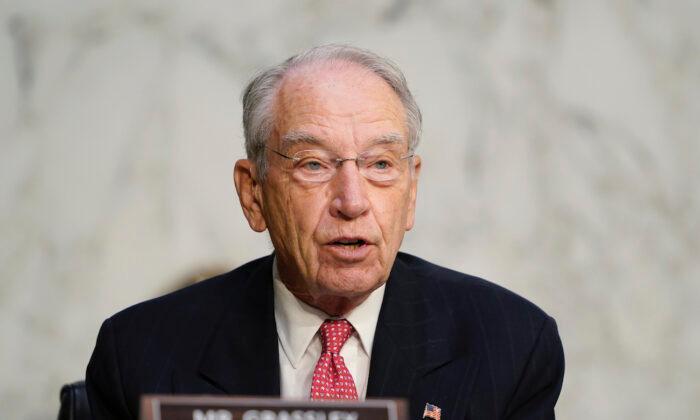Closed-door testimony by former top FBI lawyer James Baker revealed that a lawyer at Perkins Coie gave him information alleging that a Russian bank had been communicating with a server in Trump Tower—an allegation later proven false.
Perkins Coie partner Michael Sussmann, whose firm had been retained by the Democratic National Committee (DNC) and Hillary Clinton’s 2016 presidential campaign, provided information to Baker and at least one journalist ahead of the FBI’s application for a FISA warrant to spy on Trump campaign foreign policy adviser, Carter Page.
Perkins Coie also was the law firm that had hired Fusion GPS—on behalf of the DNC and the Clinton campaign—which in turn hired former British MI6 agent Christopher Steele to produce the dossier that has become known as the Steele dossier.
Sussmann’s identity as an outside source to Baker had previously been reported. But new details regarding the specific information that Sussman provided to Baker, as well as their interactions and timing, and the FBI’s response, were revealed in Baker’s testimonies.
Baker’s testimonies before the House Judiciary and Oversight committees were conducted on Oct. 3 and Oct. 18 in an unclassified setting with legal counsel present. The transcripts have not been publicly released, but were obtained for this article. (Note: Sussmann’s name is spelled incorrectly as “Sussman” in the transcript from Day One. The transcript from Day Two contains the correct spelling.)
Sussmann’s name came up during the first day of Baker’s testimony when he was asked whether it was “normal practice for general counsel to talk to confidential human sources.”
Mr. Baker: There is another occasion that I can think of where somebody brought material to me, based on a preexisting relationship. They gave the material to me. Same situation [as Corn]. I was quite concerned about it. I gave it to the investigator --
Rep. Meadows: And who was that?
Mr. Baker: Who was that?
Rep. Meadows: Yeah.
Mr. Baker: Michael Sussman.
Baker acknowledged that he had a “personal relationship” with Sussmann, as they had previously “both worked in the criminal division together at the Department of Justice.”
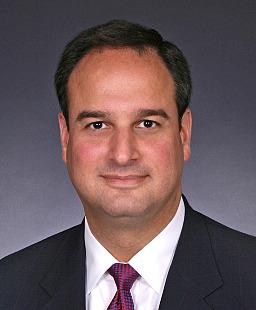
Michael Sussmann, partner at Perkins Coie, the law firm hired by the DNC and the Clinton campaign during the 2016 elections. Courtesy Perkins Coie
Sussmann had sought out Baker directly, going so far as to make an appointment in advance. As the FBI’s general counsel, Baker advised senior FBI leaders, including FBI Director James Comey and Deputy FBI Director Andrew McCabe, on the legal aspects of key investigations, and he served as the liaison with the Department of Justice (DOJ).
The significance and importance of Baker’s position within the FBI was noted by the lawmakers. At one point during testimony, Rep. Jim Jordan (R-Ohio) asked Baker: “Is it fair to say that any materials passed by the FBI general counsel automatically have a reliability and a level of credibility attached to them? You’re the FBI’s general counsel, if you’re getting information from an outside source and passing it, [sic] on that means something.” Baker responded, “I suppose so, Congressman.”
By using his personal relationship with Baker, Sussmann was able to ensure that the information he was bringing to the FBI would immediately receive investigative attention. Which is precisely what happened:
Rep. Jordan: And people are going to take seriously when the FBI general counsel has some source giving them information related to a pretty darn important investigation, they’re going to take that pretty seriously and follow up on it.
Mr. Baker: Within the organization, the Bureau?
Rep. Jordan: Yes.
Mr. Baker: Yes, I would say so.
During their initial meeting, Sussmann told Baker “he had cyber experts that had obtained some information that they thought they should get into the hands of the FBI.” Who these “cyber experts” were and where they got their information was not disclosed.
According to Baker’s testimony, the information provided by Sussmann appeared to be substantial:
Mr. Baker: It was like -- my recollection was it was a stack of material I don’t know maybe a quarter inch half inch thick something like that clipped together, and then I believe there was some type of electronic media, as well, a disk or something.Sussmann, whose Perkins Coie bio describes him as “a nationally-recognized privacy, cybersecurity and national security lawyer,” was also the lawyer the DNC turned to on April 28, 2016, after discovering the alleged hack of their servers. Immediately following the alleged discovery, DNC CEO Amy Dacey called Sussmann at Perkins Coie. After speaking with Dacey, Sussmann contacted Shawn Henry, CSO and president of cybersecurity technology firm CrowdStrike.
Sussmann was never interviewed by the FBI, which Baker found surprising, noting, “It is logical to me that we would go back and interview [Sussmann].” Sussmann was interviewed by the House Permanent Select Committee on Intelligence on Dec. 18, 2017.
Under questioning, Baker revealed that the information from Sussmann was “unrelated to the [Steele] dossier, it’s another investigative matter.” Baker was then asked if the information pertained to the “Trump-Russia matter.”
After some interjection by the FBI lawyer from Baker’s old division, the Office of General Counsel, Baker acknowledged the information Sussmann brought to him did indeed relate to the FBI’s Trump–Russia investigation.
Baker was asked whether this meeting with Sussmann occurred “before the election or after the election?” Baker noted that he thought it occurred before the election. From there, his memory became less clear.
During Baker’s second day of testimony, lawmakers came to the interview with Baker’s calendar in their possession and provided an initial meeting date between Baker and Sussmann of Sept. 19, 2016. This date would later prove to be significant.
According to Baker’s testimony, there appears to have been at least three meetings—the first in person and at least two subsequent meetings by phone.
Baker was asked if this type of interaction with an outside counsel had ever occurred before. In response, Baker admitted that his interaction with Sussmann was singularly unique:
Rep. Jordan: [This] is the first time and to your recollection the only time an outside counsel had information and was wanting to make sure it got to the general counsel of the FBI, and it happened to deal with the Russia investigation.
Mr. Baker: I that that’s correct. Sitting here today, that’s the only one I can remember.
Sussmann’s Leak to the Media
During the second day of Baker’s testimony, he said that during a subsequent “follow-up” conversation he understood that Sussmann was also talking to the media, noting that Sussmann had told him “some elements of the press had this information as well and were going to publish something about it.”In either the second or third conversation, Baker came to understand The New York Times was also in possession of Sussmann’s information. As would become clear later, other members of the media also had this same information.
Comey and McCabe Appear to Have Been Involved
According to Baker, this created a problem for the FBI, which had already begun to investigate the information provided by Sussmann. After FBI leadership realized that Sussmann was speaking with the media, Baker was asked, possibly by Comey himself, to go back to Sussmann and see if he would be willing to get The New York Times to delay publishing:Rep. Jordan: [And] the people who asked you to make that call back to Mr. Sussman and ask him, you know, to delay, who were those people?
Mr. Baker: I don’t specifically recall, but I believe it was the --
Rep. Jordan: Priestap.
Baker: I think it was Priestap, and I think it might be --
Rep. Jordan: Strzok? Peter Strzok?
Baker: It may have been, but I am also thinking it was the director and/or the deputy director.
As Sussmann was actually the source for The New York Times, he had the ability to force the paper to hold off on publishing, which they apparently did:
Mr. Baker: He was the source -- he told me the New York Times was aware of this. We, the FBI, went to the New York Times and then started a series of conversations with them to try to get them to slow downBaker testified there were a number of high-level FBI officials involved in the investigation of Sussmann’s information:
Rep. Jordan: But McCabe, Comey, Priestap, and Strzok you believe were involved, that is the “we” who came to you and said call Mr. Sussman back and --
Mr. Baker: Some combination of those people in a set of conversations over some period of time, yes. I know that is vague. I apologize, but that is what I recall.
Baker made several mentions of McCabe but also noted Comey’s involvement during his testimony, telling lawmakers that “we briefed him on it.” Notably, Baker said he didn’t “remember Lisa [Page] being involved in this part.” Interestingly, the texts between Lisa Page, who served as McCabe’s personal counsel, and FBI agent Peter Strzok make it appear as if they were jointly involved in most facets of the various investigations.
Baker had avoided discussing exactly what information Sussmann had provided, but late on the second day of his testimony, he was asked some specific questions about an article published in Slate Magazine:
Rep. Jordan: It talks about some bank in Russia, Alfa-Bank, communicating with some Trump financial institutions in the server there.
None of that kind of conversation was related to you by Mr. Sussmann when you met?
Baker: Oh, yes. I mean, that is what he told me about. Yeah, absolutely.
After consultation with FBI legal counsel, Baker said he would describe the information he received from Sussmann in a general sense:
“He was describing a -- what appeared to be a surreptitious channel of communications -- communication between some part of President Trump’s, I'll say organization but it could be his businesses. I don’t mean like The Trump Organization, per se. I mean his enterprises with which he was associated. Some part of that and a -- an organization associated with -- a Russian organization associated with the Russian Government.”Baker was describing alleged communications between Alfa Bank and a server in the Trump Tower. These allegations, later proven to be false, became the subject of much media speculation.
Sussmann Meeting Followed New Steele Memos
Baker’s initial meeting with Sussmann took place on Sept. 19, 2016. The timing is particularly notable as Steele had just produced a series of three new memos dated Sept. 14, 2016. One of these memos directly referenced Alfa Bank—misspelled in Steele’s memo as “Alpha.”On Sept. 23, Michael Isikoff of Yahoo News published his article on Carter Page, “U.S. Intel Officials Probe Ties Between Trump Adviser and Kremlin.” His article, which came from information provided by Steele, would later be cited by the FBI in the Page FISA application.
The same day, Hillary for America released a statement touting Isikoff’s “bombshell report” with the full article attached.
At exactly the same time, on Sept. 23, Politico published the lengthy article “Who Is Carter Page? The Mystery of Trump’s Man in Moscow” by Julia Ioffe. Within the article were a number of intriguing hints as to what was transpiring behind the scenes:
“As I started looking into Page, I began getting calls from two separate ‘corporate investigators’ digging into what they claim are all kinds of shady connections Page has to all kinds of shady Russians. One is working on behalf of various unnamed Democratic donors; the other won’t say who turned him on to Page’s scent.”Ioffe noted that “seemingly everyone I talked to had also talked to the Washington Post, and then there were these corporate investigators who drew a dark and complex web of Page’s connections.”
Ioffe had also been told of rumors regarding Alfa Bank:
“In the interest of due diligence, I also tried to run down the rumors being handed me by the corporate investigators: that Russia’s Alfa Bank paid for the trip as a favor to the Kremlin; that Page met with Sechin and Ivanov in Moscow; that he is now being investigated by the FBI for those meetings because Sechin and Ivanov were both sanctioned for Russia’s invasion of Ukraine.”
The Alfa Bank Allegations
The information that Sussmann provided to Baker on Alfa Bank’s alleged communications with a Trump Tower server was later detailed in a since-debunked article by Slate, “Was a Trump Server Communicating With Russia?” The article, which was published on Oct. 31, 2016, concerned allegations regarding a server in the Trump Tower that had allegedly been communicating with a server at Alfa Bank in Russia. Both the FBI and The New York Times found the allegations to be unfounded. Nevertheless, the article was used to promote the Trump–Russia collusion narrative.On the very same day, Oct. 31, 2016, two other related articles were also published. The first, “Investigating Donald Trump, F.B.I. Sees No Clear Link to Russia” by The New York Times, appeared to be an updated version of the article they had intended to publish before the FBI asked them to delay their reporting. It stated:
“In classified sessions in August and September, intelligence officials also briefed congressional leaders on the possibility of financial ties between Russians and people connected to Mr. Trump. They focused particular attention on what cyberexperts said appeared to be a mysterious computer back channel between the Trump Organization and the Alfa Bank, which is one of Russia’s biggest banks and whose owners have longstanding ties to Mr. Putin.
“F.B.I. officials spent weeks examining computer data showing an odd stream of activity to a Trump Organization server and Alfa Bank. Computer logs obtained by The New York Times show that two servers at Alfa Bank sent more than 2,700 ‘look-up’ messages—a first step for one system’s computers to talk to another—to a Trump-connected server beginning in the spring. But the F.B.I. ultimately concluded that there could be an innocuous explanation, like a marketing email or spam, for the computer contacts.”
The other article published on Oct. 31, “A Veteran Spy Has Given the FBI Information Alleging a Russian Operation to Cultivate Donald Trump” by Mother Jones reporter David Corn, provided the first public reporting on the existence of the Steele dossier:
“A former senior intelligence officer for a Western country who specialized in Russian counterintelligence tells Mother Jones that in recent months he provided the bureau with memos, based on his recent interactions with Russian sources, contending the Russian government has for years tried to co-opt and assist Trump—and that the FBI requested more information from him.”Notably, Corn’s article also mentioned Alfa Bank:
“(In recent weeks, reporters in Washington have pursued anonymous online reports that a computer server related to the Trump Organization engaged in a high level of activity with servers connected to Alfa Bank, the largest private bank in Russia. On Monday, a Slate investigation detailed the pattern of unusual server activity but concluded, ‘We don’t yet know what this [Trump] server was for, but it deserves further explanation.’ In an email to Mother Jones, Hope Hicks, a Trump campaign spokeswoman, maintains, ‘The Trump Organization is not sending or receiving any communications from this email server. The Trump Organization has no communication or relationship with this entity or any Russian entity.’)”All three articles came out on Oct. 31, 2016, including The New York Times article. Recall, the The New York Times had been asked to refrain from publishing while the FBI was investigating the matter. Which begs the question, were the authors of these other two, highly coincidentally timed articles also asked to delay their publication? It certainly seems as if all three were given the green light at the same time.
This raises the question of whether Sussmann was also leaking to Franklin Foer of Slate and David Corn of Mother Jones. Or whether Fusion GPS co-founder Glenn Simpson, whose firm had hired Steele, was acting as a conduit to these individuals.
It’s possible another explanation exists for the same-day publication of all three articles, but the concurrent timing, along with details from Baker’s testimony, appears to suggest otherwise.
On the same day, Oct. 31, Hillary Clinton sent a tweet that included a statement from Jake Sullivan, a senior policy adviser:
“Computer scientists have apparently uncovered a covert server linking the Trump Organization to a Russian-based bank.”Sullivan’s statement referenced the Slate article and included the following:
“This could be the most direct link yet between Donald Trump and Moscow. Computer scientists have apparently uncovered a covert server linking the Trump Organization to a Russian-based bank.
“This secret hotline may be the key to unlocking the mystery of Trump’s ties to Russia. It certainly seems the Trump Organization felt it had something to hide, given that it apparently took steps to conceal the link when it was discovered by journalists.”
With this statement from the Clinton campaign, combined with the Slate article and the Mother Jones article, the Alfa Bank story took off—despite the same-day story from The New York Times that specifically noted the FBI had investigated that matter and found nothing untoward.
Sussmann’s decision to choose Baker as his FBI contact proved highly effective.
Jeff Carlson is a regular contributor to The Epoch Times. He also runs the website TheMarketsWork.com and can be followed on Twitter @themarketswork.

